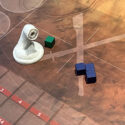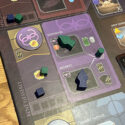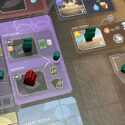‘Dune: Imperium – Uprising’ Board Game Review

Whilst we haven’t covered the original Dune: Imperium here at Nerdly, we did cover the very nice Dune: Imperium – Deluxe Upgrade Pack and I have played the base game a lot. Basic Dune: Imperium has become one of the most popular modern games of the moment, with copies available in almost every game group and a huge number of people fully invested in both the base game and the three major expansions we’ve already had for it. However, so much play tends to draw out problems, and Dune: Imperium has its fair share. Dune: Imperium – Uprising is a brand-new standalone expansion that seeks to iron out any issues for existing players whilst offering an optimised, streamlined experience for newcomers.
For someone not used to modern board games, Dune: Imperium – Uprising is definitely what I would describe as a fairly complex game. Players will each represent one of the leaders in the Dune universe (specifically, those from the upcoming second movie and including the actors full likeness) with an objective to score the most victory points. Each leader has a couple of unique features – one usually being a passive or conditional activated effect and the other being an effect that is triggered when a certain card from their hand is played.
Gameplay is a mixture of both worker placement and deckbuilding, and both are equally important to success in Dune: Imperium – Uprising. Each player begins the game with a basic deck of ten cards (of which five are drawn) and two agent meeples, as well as three spies. These spy pieces are a new addition to the Dune: Imperium games and have been included mainly to enable a little bit more flexibility when critical spaces have been occupied by enemies, or to add a small consolation boost when they are withdrawn to your player mat for any other reason. I’ll come on to them in a bit more detail later.
When the game begins, the players will take one turn each and in most cases, will play one of their agents onto a board space by spending a card that has a matching symbol. Different areas of the board have different symbols, so you can only visit a particular guild (such as the Fremen or Bene Gesserit) if you have an appropriate card, and conversely, a guild card probably won’t allow you to access a planet space. For new players, this is the most jarring thing to get an understanding of – yes, it’s worker placement as you may know it, but unlike in most other games, spaces are only accessible if you can play a card to match.
After each player has placed an agent (one at a time) and there have been two rounds of play, the players will (usually) have three cards in hand but no agents to call upon to place. At this point, that player will take a Reveal Turn, where they simply place all remaining cards on the table and take the benefits printed on the very bottom of the card. During the first few turns, this will be pretty limited to either influence (which is used to buy new cards) or daggers, which simply add to that players strength total during the combat round that follows all the reveal turns. I will mention briefly that some cards have white boxes on them, and any benefits printed here are given when the card is used for an agent turn, and not a reveal turn.
When a player goes to spend their influence on new cards, they will have five to choose from in a face up market of shuffled cards, and then two standard cards that are always available. The idea here is to spend that influence on something that will help you maximise your strategy for the game – whether that is combat victories, guild influence, spice cultivation or whatever else takes your fancy. Newly acquired cards are placed into your discard with all the cards you used during your turn, and then you’ll draw a new hand. Eventually, depending on how big your deck is (ahem… and you don’t want it too big, believe me) you’ll start to draw those more powerful cards that you’ve bought and you can begin to exert your influence on the planet of Dune.
In terms of specifically what is new in Dune: Imperium – Uprising, let’s talk about the spies. These guys are placed onto specific, circular spaces on the board that have little lines out towards the adjacent agent spaces. In short, spies allow a player to place an agent on a space that has already been occupied by an opponent (at which point the spy has to be returned). Spies can also be returned as a cost printed on a card for whatever benefit is shown, or if all else fails, you can withdraw a spy to simply draw an additional card. There is also a CHOAM space which allows players to draw contracts that can be fulfilled for a reward.
Finally, perhaps the biggest addition to Dune: Imperium – Uprising are the additions to conflict scoring and the inclusion of the sandworms. To explain these, I need to cover off conflict – in Dune: Imperium – Uprising players add troops to the current conflict through the action cards and agent spaces they use and activate. At the end of the round (after all agent and reveal turns) players compare strength, potentially add intrigue cards (which may add more strength or even some trickery to the mix) and then determine who wins what spoils based on the current conflict card. First strongest gets top prize, second gets second and so on, whilst ties bump both tied players down one level.
In Dune: Imperium – Uprising, each conflict card now includes a small symbol on the top corner (which will also match a card you’re dealt at the start of the game) and for each pair of these, you’ll score one point. In practical terms, this is a game where 10 points triggers the end of the game and often, 10-11 or at most 12 will be enough to win – so one point is huge. This adds a focus on combat in Dune: Imperium – Uprising that was never there before, and I really support this simple and effective addition. Sandworms are the other big change, and although these guys are expensive to get into the fight (requiring a Maker Hook token, which costs both resources an action to obtain) they are strength 3 (which is huge) and they double the spoils of any conflict in which they participate.
There are, of course, a raft of other minor changes and improvements. One change that returning players will notice is that a specific area of the board has a shield wall that prevents sandworms from fighting in certain conflicts – and it’s a fairly high level play to both take this shield down and recruit and deploy a sandworm in the same conflict. That said, the landscape for Dune: Imperium is so competitive these days (with big prize tournaments part of the scene) that such high level play absolutely needs to exist in Dune: Imperium – Uprising and should be exploited wherever possible. Other changes and improvements include a completely new deck of cards (which is almost all new cards, most of which are more interesting than those in the base game) and revised board spaces that just help streamline the game.
In summarising, Dune: Imperium – Uprising is simply a much better game than Dune: Imperium and I doubt that I would ever go back to the older version now. I can make this statement with confidence because having grown a bit tired of Dune: Imperium over the past year or so and because I’ve not played it, I’ve already handed over my old copy and replaced it completely with Dune: Imperium – Uprising. I don’t think I’d ever want to go back to a vanilla version of the original game now, and the various expansions, whilst improving upon it, make the game bloated and hard to teach. Dune: Imperium – Uprising corrects almost all issues with the original game, whilst also adding team play (for up to six people) and a much improved board and deck of cards should you simply wish to add it to your existing set.

















































